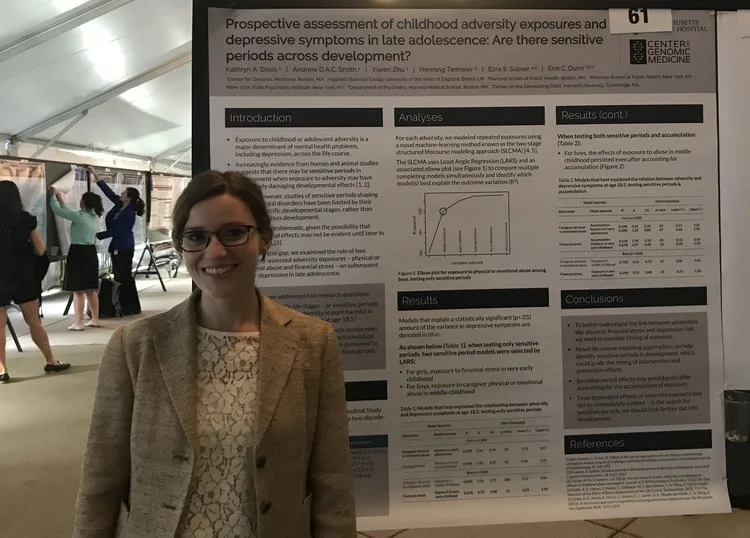The Dunn Lab at MGH’s Clinical Research Day
Clinical Research Day at Massachusetts General Hospital is an annual event that celebrates clinical and translational research accomplishments from the past year. It’s also a great chance for researchers to share their work with each other and the MGH community and discover new opportunities for future research and collaboration.
This year, over 300 projects were highlighted, spanning psychiatry, to emergency medicine, neurology, pediatric surgery, and many other departments.
Five members of the Dunn Lab participated in this year’s Clinical Research Day. Here’s a summary of what they shared:
By: Katie Davis
There's solid evidence to think that there might be sensitive periods in development when exposure to adversity is particularly detrimental, but so far most studies on this topic have looked at a limited set of developmental stages, instead of outcomes across development. Using prospective data from a large birth cohort, we aimed to determine if there were sensitive periods when the effects of either abuse or financial stress raised the risk for depression at age 18. And, if sensitive periods were identified, we also wanted to see if the effects of these adversities during a sensitive period persisted after accounting for the accumulation of adversity exposures. We found support for two sensitive periods that heightened risk for depression: exposure to financial stress in very early childhood in girls, and exposure to abuse in middle childhood in boys. For boys, the effects of this sensitive period persisted even after accounting for the number of time periods of abuse exposure. Our study shows that novel life course modeling approaches like the one used here can help us identify sensitive periods in development and may provide a guide for timing of intervention and prevention efforts. These findings also suggest that time-dependent effects of adversity exposure might not be immediately evident, and that in the search for sensitive periods, we should look farther out into development.
2. Reports of parent-to-child maltreatment: How often do parents and children agree and what are the predictors of disagreement?
By Sam Ernst
Child maltreatment is known to be associated with many poor health outcomes; however, there is no gold standard for measuring exposure to maltreatment. Conflicting reports, depending upon the reporter, make it even more difficult to draw conclusions about the impact of such exposures. To address these challenges, we explored the agreement between reports of maltreatment as reported by mother, partners, and children. We also examined whether different demographic and familial factors predicted disagreement between reporters. There was high mother-partner agreement when reporting maltreatment. However, there was low to moderate agreement between caregiver (mother and partner) and child reports, with children reporting more maltreatment. Demographic factors, such as maternal education, maternal depression, and the mother’s age at her child’s birth, were predictors of disagreement between reports. The discrepancies we found between caregiver and child reports highlight the need for researchers to critically consider how they measure maltreatment. Additionally, these results reflect that there may be certain characteristics that can predict reliability between reporters, which could have implications for child maltreatment surveillance and studies seeking to use self-report measures of maltreatment exposure.
3. Do different measures of psychological resilience correlate with each other and predict health outcomes to the same degree? Results from a large, epidemiological sample
By Kristen Nishimi
There is currently no single, agreed-upon definition of resilience in the field. Thus, it is challenging to study and measure resilience, especially when drawing comparisons across different studies. After generating four different measures of psychological resilience among individuals who had experienced child abuse, we examined these measures in relation to sociodemographic factors as well as with body mass index (BMI). The four resilience measure were only moderately correlated with each other. However, the pattern of association between most sociodemographic factors was the same across resilience measures. For example, higher socioeconomic status was generally associated with higher resilience. Resilience was associated with significantly lower BMI levels, when assessed with two of the resilience measures. These findings suggest that existing measures of resilience are moderately correlated with each other and associate with outcomes to different degrees. Future research should continue to examine measurement congruence across multiple definitions of psychological resilience in diverse samples.
4. When Novel Statistical Methods Meet Big Data: The Benefits of Simulations
By Yiwen Zhu
Although novel statistical methods are increasingly being used in the big data setting, it is unclear whether and what problems may arise in the translation of such methods to high dimensional data. This can lead to misinterpretations of results. We performed simulations to examine the performance of a set of novel statistical methods, called post-selection inference, when applied to epigenome-wide data. We examined whether the methods produced inflated results when there was actually no true association. We also investigated if any of these novel statistical methods were more effective than others in identifying true associations. We found that each of the post-selection inference methods performed quite differently when examined in a big data context. The study shows how simulations can provide valuable insights and that simulations should be more commonly used in big data analyses.
5. Using Mendelian Randomization to Test Causal Bidirectional Influences Between Physical Activity and Depression
By Karmel Choi
Although physical activity is known to associate with risk for depression, it remains unknown whether exercise may be causally associated with reductions in such risk. Using an approach called Mendelian randomization, which leverages genetic variation as a type of natural experiment, we tested bidirectional influences between physical activity and depression. We found that physical activity reduces risk for depression - particularly when examining genetic variation previously linked to objectively measured activity (via wearable devices). This genetically informed approach provides further support for physical activity as an effective prevention strategy for depression.




